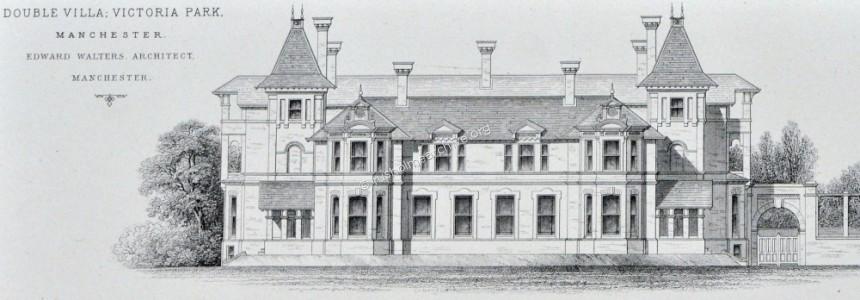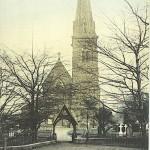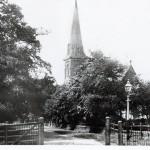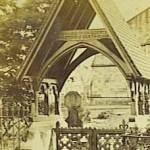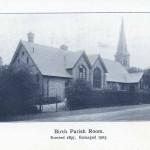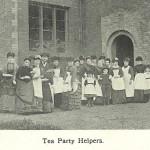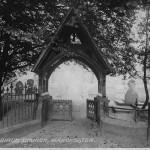Rusholme & Victoria Park Archive
'Across the fields to the Church'
The view below is from a card marked 1906, but the photo may be earlier, the camera must be somewhere near the Hollings College area, (Cromwell Grange perhaps?) as houses would otherwise be in the view. The building on the right is St James Rectory.
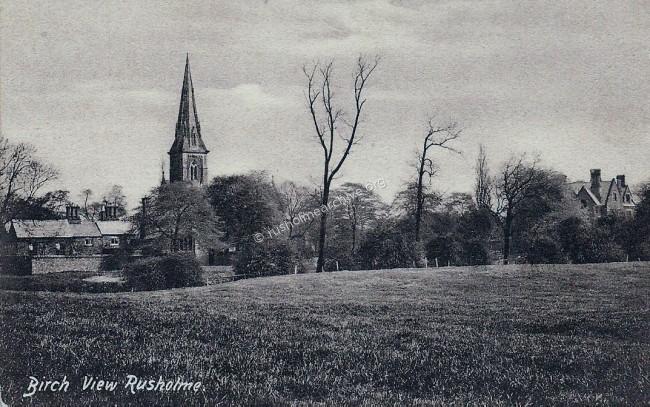
The inhabitants of Rusholme were, previous to the seventeenth century, few in number, consisting of less than forty families, and the old chapel, doubtless built of wood, close by Birch Hall, was originally erected in Queen Elizabeth's reign as a domestic chapel by that family, for the use of themselves and their dependents and neighbours.
The family of Birch were comparatively non-conformist and this little chapel attracted some 'notoriety' in the seventeenth century.....................
The following extract is from a History of Manchester by F A Bruton, published in 1924.
'RELIGIOUS CONTROVERSIES
'The church known to-day as St. James's, Birch, occupies the site of one of the little local chapels mentioned in an earlier chapter; this one having been built in the reign of Elizabeth, doubtless originally for the use of the family at Birch Hall, whose sympathies seem to have been with religious freedom. In 1646 a certain minister, having tried for some time to inculcate " Independent " principles at Gorton Chapel, moved to Birch, and there set up 'congregational-ism'. There were objections from the more 'orthodox' church and eventually the minister resigned.
However, Birch Chapel, continued to be especially suspect. People met to worship at Birch Hall by stealth. There are extant lists of inhabitants of Rusholme who were reported by specially-appointed watchers for not attending the parish church, (they having been seen to enter Birch Chapel), and these were fined accordingly.
In 1673 the King permitted non-conforming ministers to obtain licences to preach in private houses. Even then the minister of Birch Chapel was interfered with, and eventually, in 1697, with the assistance of friends, he erected the little chapel at Platt, and became its first minister, the ground being given by the Worsleys of Platt, another family with Nonconformist leanings.
As the middle of the 19th century approached it was very obvious that the small chapel at could not hold the increasing population of Rusholme.
The pencil sketch below is a presumed view of the chapel which was was demolished circa 1846 at the same time the new church was being built.
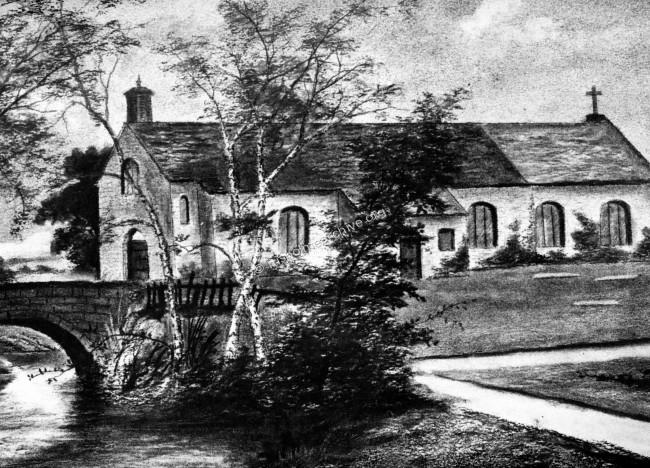
Sir John William Hamilton Anson was the eldest son Sir George Hamilton Anson.
Sir George had married the daughter of John Dickenson and through this marriage inherited the Birch Estate. When Sir George died his eldest son John inherited Birch & other estates & the title, but in particular the gift of the incumbency at Birch Chapel.
Sir Johns younger brother, George Henry Greville Anson has been ordained a deacon in 1843, becoming at curate at Leeds where the incumbent was a Dr. Hook. Whilst still working in Leeds he was planning to become the Rector at the proposed new church at Birch.
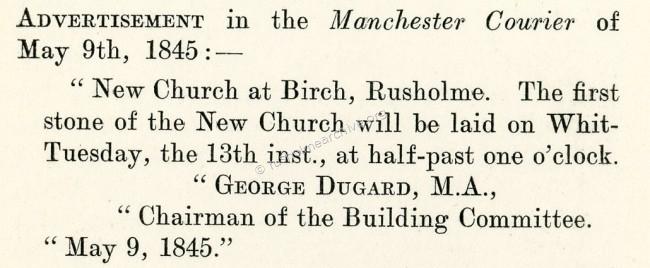
Below is the cover of a 23 page pamphlet that is a report on the laying of the foundation stone in 1845
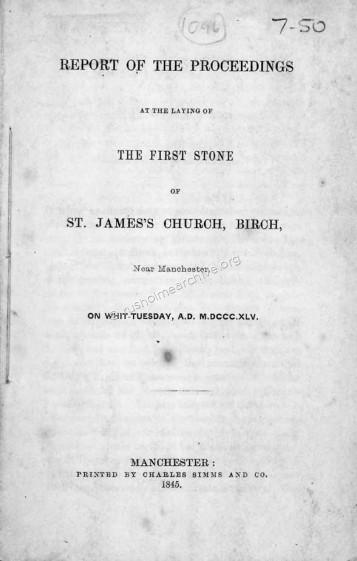
The opening page of the Report is reproduced below and it clearly makes apparent the generosity of the Anson family in providing land, money & ultimately the incumbent!
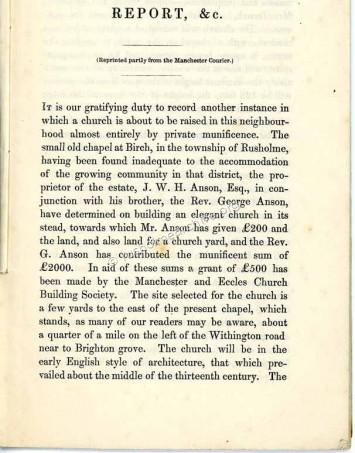
Another page of the Report listing some of the Guests.
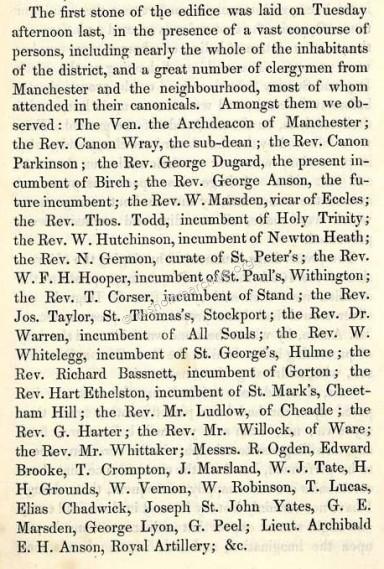
Predictably there was some self congratulation at the proceedings........
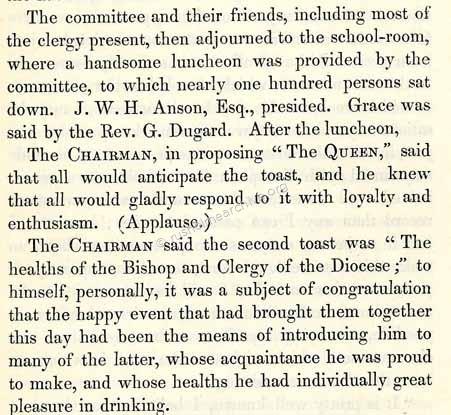
A handsome luncheon was something probably not very new to the Rev. Anson when you read below that he had been educated at Eton & Oxford!
If you would like to read the 23 pages of the proceedings I have scanned the entire document. It can be downloaded and read provided you have Adobe installed.
Click below on the PDF link
Rev George Henry Greville Anson
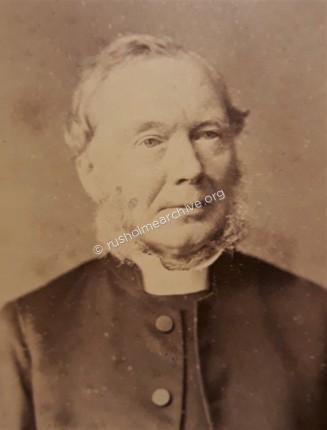
The Rector, George Henry Greville Anson was incumbent at St James Birch from 1846 until his death in 1898. He was educated at Eton, Christ's Hospital and Exeter College, Oxford. The Archdeacon was at Oxford in exciting times, and took a great interest in the Tractarian movement, headed by Newman, Keble and Pusey.
It may have been that at Oxford he had met John Ruskin. In 1864 Rev. Anson invited John Ruskin to Rusholme where he gave a lecture at the newly built Rusholme Institute, (Dickenson Rd) called, 'On Kings Treasuries'.
He was ordained as curate of St Saviours, Leeds under Dr. Hook, and he eventually married Augusta Agnes, daughter of Dr. Hook.
Dr Hook was a well known Victorian figure in the Anglican church and now merits four pages in the Dictionary of National Biography. He had shown considerable sympathy to the Tractarian movement and this may have influenced Anson in the choice of Derrick, the architect for the new church at Birch.
Dr Hook became a regular visitor to Birch-in-Rusholme and was known to have been a speaker at the Birch Literary Society.
CDV of Dr Hook below
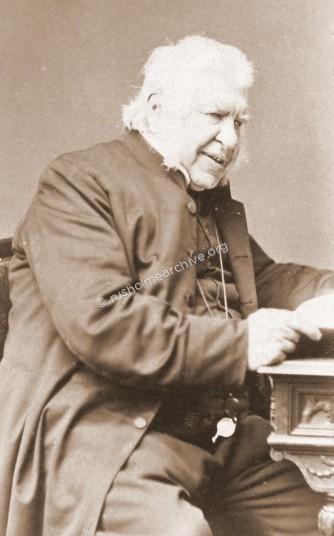
It was against this background that Rev Anson had commissioned the architect, John Macduff Derrick to design the new church, St James. Anson had seen his design for a work at Oxford, (The Martyrs Memorial, but not commissioned) and when he became the curate at St Saviours, Leeds the newly built church there was also by Derrick. John Derrick is said to have trained under Sir John Soane and was a friend of Pugin. The total cost of the church was £4,300.
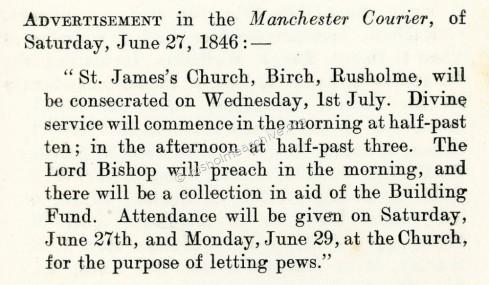
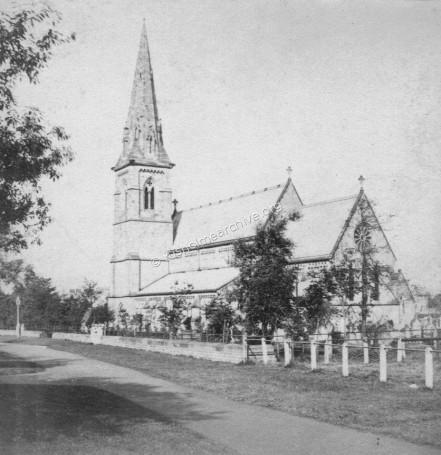
Photograph above from the mid 1860's by Helmut Petschler.
Buckley described the church in his book in the following terms;
'The style is that known as lancet or Early English, a style which prevailed during the earlier part of the thirteenth century. The Church is remarkable for simplicity, exhibiting externally an almost entire absence of ornament; the architect's design being to show what could be done by attention to massiveness, and at the same time to the due proportion of its several parts. The Church has been admired as one of the best specimens of its style; the proportions are well balanced, and the interior is in. keeping with the exterior.'
Below is an undated view of the interior
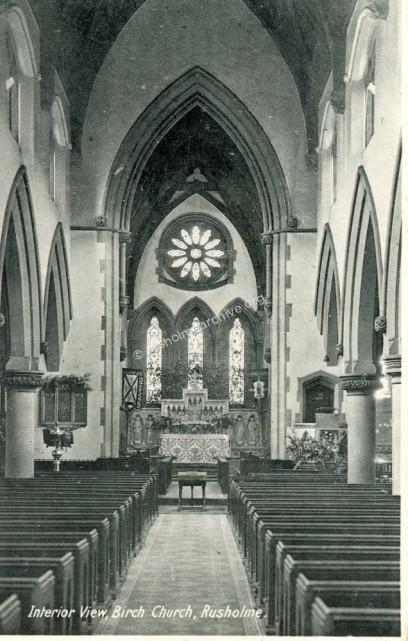
Photograph below is dated 1898
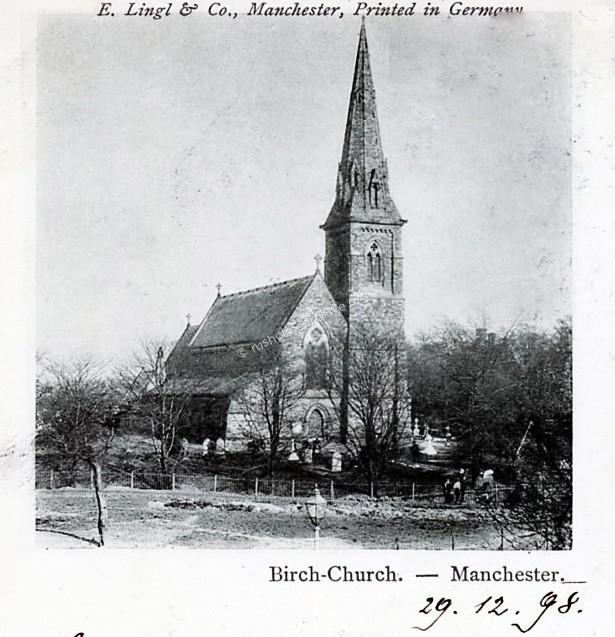
If you would like to read a detailed biography of Derrick follow the link below Click on the back button of your browser to return to this website
The Rectory at St James.
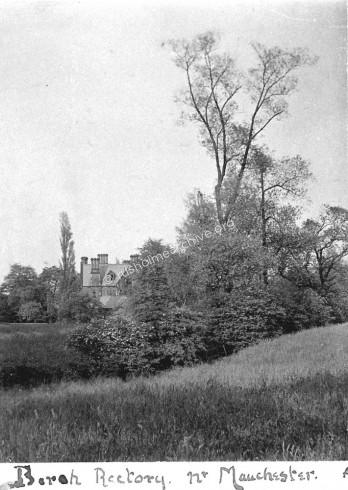
Construction of the Rectory did not start until 1854 when a London architect, Lewis Stride was commissioned to create a suitable home for the younger son of a Baronet.
Before the large Rectory was built on land adjoining the Church the Rector and his wife lived in a rather more modest home on Moon Grove, off of Dickenson Road.
To quote from J S Buckleys book;
'Before the rectory was built he lived at a house where St. Mary's Home now stands, and it was here that he brought Mrs. Anson as a bride. For the sake of their health they
removed to a house in Moon Grove, number 4, the second house on the right, until the present rectory was provided. He once related a story which will bear repeating. A fire broke out in one of the rooms, and it was some time before it was extinguished. He had two maids; we will call them Sarah and Jane. Sarah had rather a good voice, and was fond of singing , " Vital spark of heavenly flame." He asked Jane what was the cause of the fire. ''I really can't say, sir," she replied, "unless it was
Sarah's vital spark."
1851 Census showing occupants at No.4 Moon Grove
ANSON, George Head Married M 30 1821 Perpetual Curate Of St.James's,Birch
ANSON, Augusta Agnes Wife Married F 20 1831
KEITH, Martha Servant Unmarried F 49 1802 Housekeeper
WILSON, Mary Servant Unmarried F 33 1818 House Maid
EVANS, Sarah Servant Unmarried F 13 1838 Kitchen Maid
1881 Census showing occupants at St James Rectory
ANSON, George H G Head Married M 60 1821 Clergyman Rector Of Birch
ANSON, Augusta A Wife Married F 50 1831
BROMHEAD, Betsy Servant Single F 37 1844 Cook Housekeeper (Domestic)
LOYDALL, Letitia Servant Single F 26 1855 Ladys Maid (Domestic)
BLAKEY, Harriet Servant Single F 34 1847 Waitress (Domestic)
HEMMINGS, Mary Servant Single M(?) 19 1862 Housemaid (Domestic)
Architects Impressions
Images below are from M315 collection, held by Manchester Archives. I should like to express my appreciation to staff at the Manchester Library Archives and The Greater Manchester County Archives in helping me find these illustrations and giving permission to display them on this website.
The Architects Specifications
In the Manchester Library Archive there is in addition to the architectural drawings a total of 26 pages of carefully handwritten instructions to the various tradesmen involved in the construction of the Rectory. Not surprisingly the instruction for each particular tradesman required that the very best materials were to be used;
ie for the Mason;
The whole of the stone to be used to be of the very respective kind and worked according to the laws of true masonry!
M315
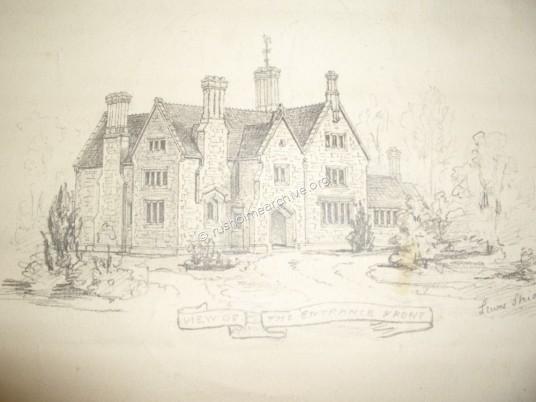
M315
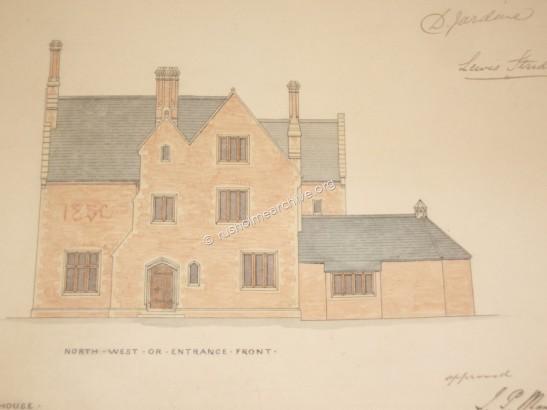
M315
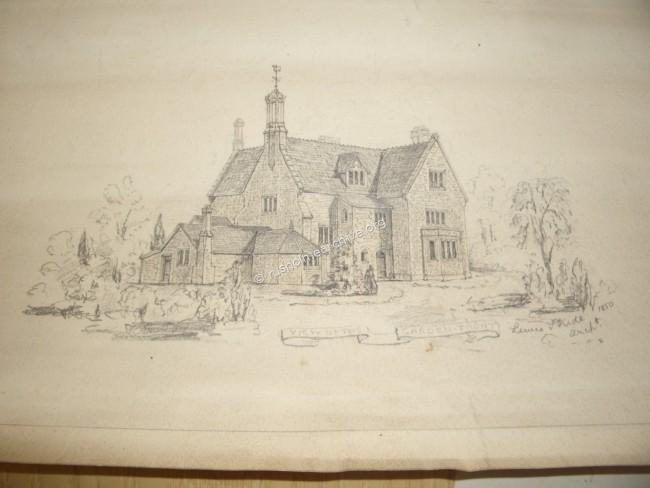
Illustration below from William Royles 'History of Rusholme'
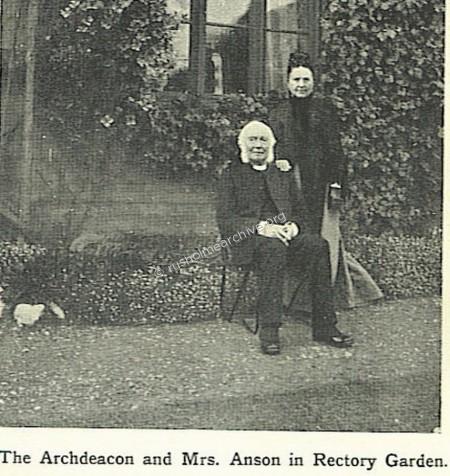
In 1929 the the Rectory was sold and can still be seen in the adjoining grounds of Manchester Grammar where it is now used as part of the school teaching premises. A house was was purchased on Norman Rd for use as the Rectory until St James Church was closed in 1980.
The Parish Hall was built in 1897 to a design by the architect Medland Taylor and then enlarged 6 years later. John Buckley referred to the Parish Hall, 'as proving to be a most useful factor in the social & spiritual life of Birch.'
Medland Taylor lived nearby in Dickenson Road, you can read more about him on the page 'Medland Taylor and his Pepperpot House
St James served the community for over 130 years, being an important centre for many of the Birch residents. The Register of Baptism & Marriages is available to search on-line:
http://www.lan-opc.org.uk/Manchester/Rusholme/stjames/index.html
The many happy events of marriage and baptisms that occurred here are testimony to the standing of this Anglican church in the past century.
Sadly many of the burials that were recorded so visibly on the many gravestones around the church are now only to be seen on photographs.
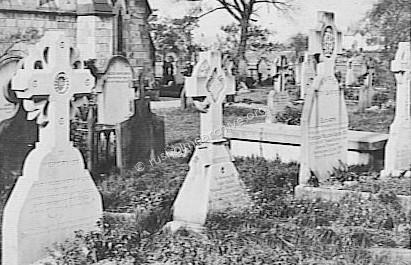
As a consequence of the Church coming into private ownership all of the gravestones, (except some that had close living relatives), were bulldozed into a big mound at the rear of the church. Many of the names of old Rusholme families buried here had their visible history cleared away so that it seemed to be almost vandalism. The names are now only records on Church documents.
A few of the significant gravestones were removed to the easterly boundary, Royle, Donner, Anson, Wright & Worsley amongst others, but these are neglected, vandalized and overgrown.
More recently,,,,, (2012), the graveyard had been tidied and the stones referred to above can now be seen.
Always considered a pretty corner of Rusholme here are some views of St James.
Remember! Wherever you see a 'Gallery' of smaller pictures as below then click on the picture and it will expand!
